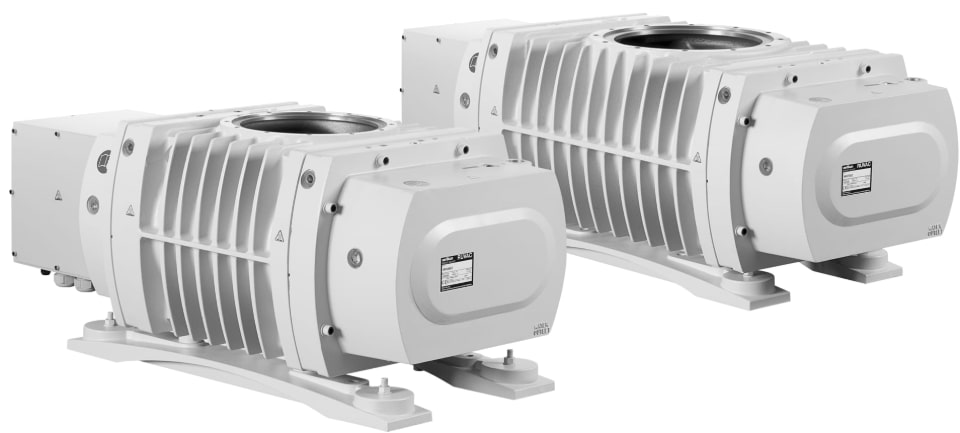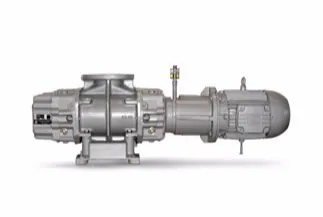Product Description
Product Description
RUVAC WAU Roots Pumps are used to increase the pumping speed at low pressures, extending the operating pressure range of the fore pumps. The WAU Roots vacuum pumps use air cooled, flange-mounted standard 3 phase motors. The WAU Roots vacuum pumps are provided with an additional integrated pressure equalization line.
RUVAC WA /WAU roots blower are secondary pumps equipped with flange-mounted air-cooled standard 3 phase motors for flexibility and are excellent for atmospheric pump down applications owing to its integrated equalization line and the bypass valve.
RUVAC WA / WAU roots blowers are equipped with radial shaft sealing rings made of FPM (FKM) (fluor polymer) for longer service intervals. RUVAC WAU roots blowers have an additional integrated pressure equalization line and a differential pressure bypass valve. These blowers are supplied with a vertical pumping flow as a standard but can be changed to horizontal flow if required.
RUVAC WA / WAU being dry roots blowers are environmentally friendly as well as air cooled saving costly water usage/disposal as well as water circuit maintenance costs. RUVAC WA / WAU have proven reliability and performance in many applications such as heat treatment, food packaging, and CHINAMFG drying.
Detailed Photos
Product Parameters
Application Ranges:
* VacHeat treatment
* Furnaces
* Metallurgy
* Vacuum coating
* Chemistry
* Packaging
* Central vacuum supply systems
* CHINAMFG drying
* Electrical engineering
* Mechanical engineering
* Automotive industry
Features
1. This vacuum pump gives the maximum vacuum degree of less than 0.5mbar.
2. The vapor is ejected at high velocity.
3. It generates low noise while operating and the signal to noise ratio is lower than 67db.
4. Our product is eco-friendly. It is applied with an oil fog clearer, so there is no oil fog existing in exhaust air.
5. Coming with compact structure as well as scientific and reasonable design, our pump is easy to be installed in the industry system.
In Stocks
On-site Projects
Certifications
Company Profile
/* January 22, 2571 19:08:37 */!function(){function s(e,r){var a,o={};try{e&&e.split(“,”).forEach(function(e,t){e&&(a=e.match(/(.*?):(.*)$/))&&1
| After-sales Service: | Online, Video, Call, Email Supports or on-Site |
|---|---|
| Warranty: | 1 Year |
| Oil or Not: | Oil |
| Customization: |
Available
|
|
|---|
.shipping-cost-tm .tm-status-off{background: none;padding:0;color: #1470cc}
| Shipping Cost:
Estimated freight per unit. |
about shipping cost and estimated delivery time. |
|---|
| Payment Method: |
|
|---|---|
|
Initial Payment Full Payment |
| Currency: | US$ |
|---|
| Return&refunds: | You can apply for a refund up to 30 days after receipt of the products. |
|---|

What Are the Differences Between Dry and Wet Roots Vacuum Pumps?
Dry and wet Roots vacuum pumps are two different types of pumps with distinct operating principles and characteristics. Here’s a detailed explanation of their differences:
1. Operating Principle:
– Dry Roots Vacuum Pump: A dry Roots vacuum pump operates without the use of any lubricating fluid or sealing liquid. It consists of two or more intermeshing lobed rotors that rotate in opposite directions, creating a series of expanding and contracting chambers. As the rotors rotate, gas is trapped in the chambers and carried from the inlet to the outlet, resulting in the generation of a vacuum.
– Wet Roots Vacuum Pump: A wet Roots vacuum pump, also known as a liquid ring pump, uses a liquid, typically water or another compatible liquid, as a sealing and working fluid. The liquid forms a rotating ring inside the pump, creating a seal between the lobes of the rotors. As the rotors turn, the liquid ring traps and carries the gas from the inlet to the outlet, creating a vacuum.
2. Lubrication and Sealing:
– Dry Roots Vacuum Pump: Dry Roots pumps do not require lubrication or sealing fluid. The absence of liquids eliminates the need for maintenance associated with fluid handling, such as oil changes or water management. Dry pumps are often preferred in applications where contamination from lubricants or sealing fluids is a concern, such as in semiconductor manufacturing or pharmaceutical industries.
– Wet Roots Vacuum Pump: Wet Roots pumps rely on a liquid seal for operation, requiring a continuous supply of sealing liquid, typically water. The liquid serves as both a sealant and a coolant for the pump. However, it also necessitates careful management of the liquid, including water supply, disposal, and potential contamination risks. Wet pumps are commonly used in applications where the presence of the sealing liquid is not a concern or can be easily managed.
3. Operation Efficiency:
– Dry Roots Vacuum Pump: Dry pumps are known for their high operational efficiency. They can achieve high pumping speeds and create substantial vacuum levels. Dry pumps are particularly suitable for processes that require quick pump-down times or applications where a deep vacuum is necessary.
– Wet Roots Vacuum Pump: Wet pumps typically have lower pumping speeds compared to dry pumps. While they can achieve moderate vacuum levels, they are not as effective in creating deep vacuums. Wet pumps are often used in processes where the pumping speed requirements are not as demanding, or in applications where the presence of the sealing liquid can provide benefits, such as in handling condensable gases or preventing contamination.
4. Application Suitability:
– Dry Roots Vacuum Pump: Dry pumps are commonly used in a wide range of applications, including semiconductor manufacturing, analytical instruments, vacuum packaging, and industrial processes. Their ability to handle different gases and their high operational efficiency make them suitable for various industries and processes.
– Wet Roots Vacuum Pump: Wet pumps find application in processes where the presence of a sealing liquid is advantageous. They are often used in applications involving the handling of water vapor, condensable gases, or corrosive gases. Wet pumps are utilized in industries such as chemical processing, pharmaceuticals, food processing, and environmental applications.
5. Maintenance and Care:
– Dry Roots Vacuum Pump: Dry pumps generally require less maintenance compared to wet pumps. They do not rely on sealing liquid, reducing the need for fluid changes, disposal, or monitoring of liquid levels. Dry pumps may require periodic maintenance, such as cleaning, inspection, and rotor lubrication, but the maintenance requirements are typically less frequent and less involved.
– Wet Roots Vacuum Pump: Wet pumps require regular maintenance due to the presence of the sealing liquid. Maintenance tasks include monitoring and replenishing the liquid, managing the water supply, and ensuring proper disposal of the used liquid. The sealing liquid may also require filtration or treatment to remove contaminants or prevent scaling or corrosion.
In summary, dry and wet Roots vacuum pumps differ in their operating principles, lubrication and sealing methods, operation efficiency, application suitability, and maintenance requirements. Dry pumps operate without lubrication or sealing fluid, offer high efficiency and are suitable for a wide range of applications. Wet pumps rely on a liquid seal, have lower pumping speeds, are used in applications where the liquid presence is advantageous, and require regular maintenance and care.

What Is a Roots Vacuum Pump, and How Does It Work?
A Roots vacuum pump, also known as a Roots blower or a rotary lobe pump, is a type of positive displacement vacuum pump that is widely used for various industrial applications. Here’s a detailed explanation of what a Roots vacuum pump is and how it works:
A Roots vacuum pump consists of two synchronized rotors, known as lobes or impellers, that rotate in opposite directions within a housing. The lobes have a unique helical shape with multiple lobes, which allows them to trap and move gas efficiently. The rotors are synchronized with the help of timing gears to maintain precise clearances between the lobes and the housing.
The operation of a Roots vacuum pump can be described in the following steps:
1. Inlet Stage: The process begins with the lobes rotating in opposite directions. As the lobes rotate, the volume between them and the housing gradually increases, creating a larger space at the inlet side of the pump. This expansion of the volume causes the gas to enter the pump through the inlet port. The gas is drawn in due to the pressure difference between the inlet and the pump’s internal chamber.
2. Compression Stage: As the gas enters the pump, it gets trapped in the spaces between the lobes and the housing. As the lobes continue to rotate, the trapped gas gets carried along the rotating lobes. The gas is essentially trapped in the pockets formed by the lobes and the housing. The rotating lobes then compress the gas as they move towards the outlet side of the pump.
3. Outlet Stage: As the lobes approach the outlet side of the pump, the volume between them and the housing decreases, resulting in the compression of the trapped gas. This compression raises the pressure of the gas, causing it to be expelled through the outlet port of the pump. The expelled gas is then discharged into the atmosphere or directed to a downstream process or another vacuum pump, depending on the application.
It’s important to note that a Roots vacuum pump operates as a non-contacting pump, meaning that there is no physical contact between the lobes or between the lobes and the housing. This characteristic eliminates the need for lubrication within the pump and reduces the risk of contamination or oil vapor backstreaming into the vacuum system.
Roots vacuum pumps are known for their high pumping speed and ability to handle large volumes of gas. However, they are not capable of achieving high vacuum levels on their own. To achieve higher vacuum levels, a Roots pump is often used in conjunction with other vacuum pumps, such as rotary vane pumps or diffusion pumps, in a hybrid or combination pumping system.
In summary, a Roots vacuum pump operates based on the principle of positive displacement. It utilizes synchronized rotating lobes to trap and compress gas, allowing it to be discharged at a higher pressure. The non-contacting design of the pump eliminates the need for lubrication and reduces the risk of contamination. Roots vacuum pumps are commonly employed in various industrial applications, especially when high pumping speed and large gas handling capacity are required.


editor by CX 2024-03-29